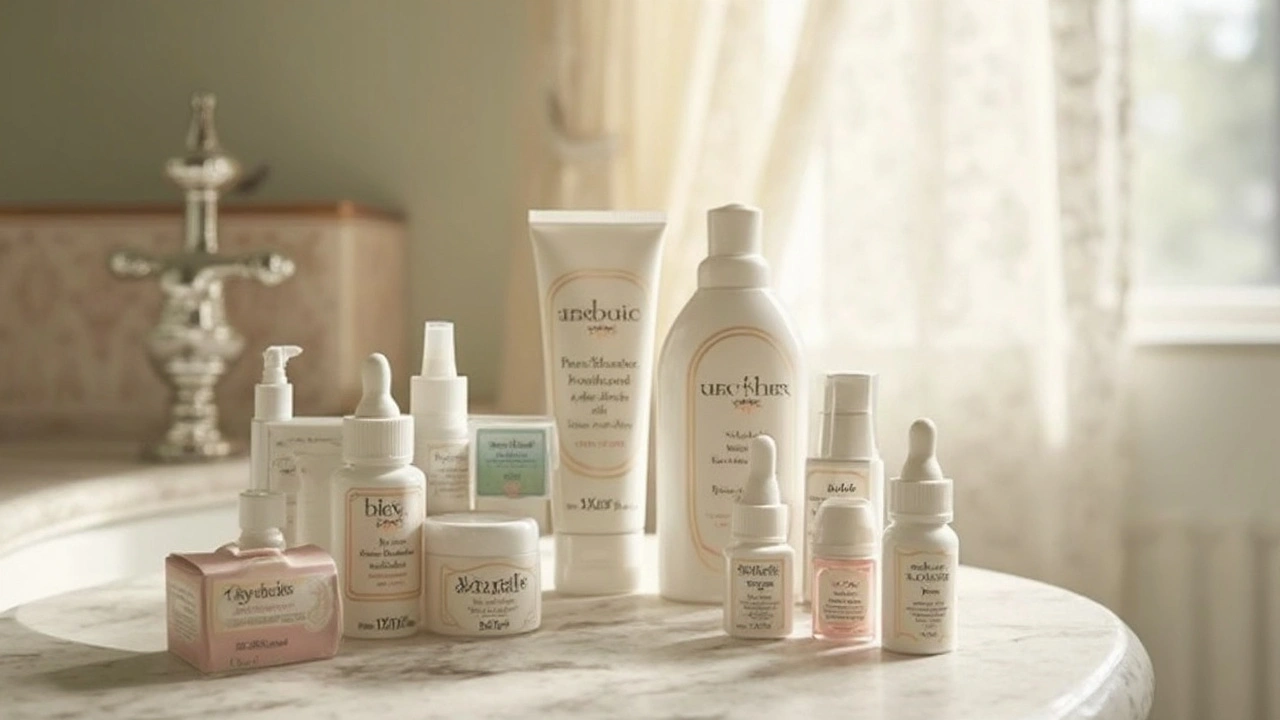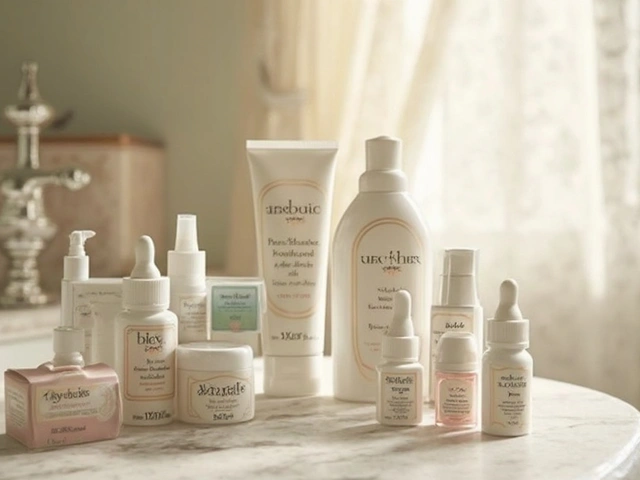Over-the-Counter Tretinoin Alternatives: Are They Effective?

When it comes to skincare, tretinoin is often hailed as a miracle worker for anti-aging and acne. But getting a prescription isn't always easy or affordable. That's where over-the-counter (OTC) alternatives come into play. But you might be wondering, are they any good?
There are some OTC options like retinol and adapalene, which are easier to get your hands on. While they don’t pack quite the punch of tretinoin, they certainly have their benefits. Understanding how these alternatives work can help you decide if they’re worth trying.
- What is Tretinoin?
- Why Look for Alternatives?
- Popular Over-the-Counter Options
- How Effective Are These Alternatives?
- Choosing the Right Product
- Incorporating Alternatives into Your Routine
What is Tretinoin?
Tretinoin, also known as all-trans retinoic acid, is a potent derivative of vitamin A. It's best known for its role in skincare, where it's used to treat acne and signs of aging. You've probably heard about its magical abilities to reduce wrinkles and improve skin texture. It's the real deal, often considered a go-to treatment when it comes to stubborn skin issues.
Why is tretinoin so special? Well, it works by encouraging skin cells to renew themselves faster, smoothing out the surface and helping to unclog pores. This action not only tackles acne but also enhances overall skin health. It can boost collagen production which tends to deplete as we age, making it a powerhouse for youthful skin.
So, if it's so great, why doesn’t everyone use it? For starters, you need a prescription to get tretinoin. It's strong and can be irritating, especially when you're just starting. Many people go through a ‘purge’ period where their skin seems to get worse before it gets better. Sounds intense, right?
Despite these hurdles, tretinoin remains a gold standard in dermatology. But for those looking for alternatives, understanding how tretinoin works can guide you in picking effective over-the-counter remedies that are more gentle on the skin.
Why Look for Alternatives?
Let’s be real, tretinoin is awesome, but it's not for everyone. Whether it’s because of accessibility, cost, or skin sensitivity, many people are on the hunt for effective over-the-counter (OTC) alternatives.
Accessibility and Cost
Getting your hands on prescription tretinoin can be a hassle. Not everyone has the time or the means for a dermatologist visit, and let's not forget about the price tag that usually comes with it. OTC options can be a lot cheaper and mean fewer trips to the doc.
Skin Sensitivity
Tretinoin can be harsh, leading to redness, peeling, and irritation especially when you're just getting started. If you have sensitive skin, jumping straight to tretinoin might not be the best idea. This is where alternatives like retinol or adapalene come into play, offering a gentler approach.
Dr. Samantha Vane, a board-certified dermatologist, once said, "OTC retinoids are like the training wheels for tretinoin. They prep your skin to handle more powerful products without overwhelming it."
Flexibility
Another reason folks look elsewhere is that some might start with retinol to see how their skin reacts before going for something stronger like tretinoin. It’s a way to test the waters and adjust based on what their skin tells them.
Ultimately, the right choice depends on your skin type, budget, and personal goals. We’re all unique, after all!
Popular Over-the-Counter Options
When you're looking for alternatives to prescription tretinoin, a few big names often crop up in conversation. These OTC options are more accessible and offer a more gentle introduction to the world of retinoids.
Retinol
First up, we have retinol. It’s probably the most well-known alternative. Retinol is a derivative of vitamin A, just like tretinoin, but it’s less potent, making it a good starting point for those with sensitive skin. It works by gradually increasing cell turnover, which helps improve skin texture and tone.
While it might take longer to see results compared to tretinoin, many people appreciate its less intense side effects. You’ll find retinol in tons of products from serums to moisturizers, making it a versatile option for any skincare routine.
Adapalene
Next on the list is adapalene, which you might recognize from popular products like Differin Gel. Unlike retinol, adapalene is actually quite similar to tretinoin but is available without a prescription. It’s often used for acne treatment, reducing inflammation and preventing new acne from forming.
People like adapalene for its effectiveness in tackling acne while being generally less irritating than tretinoin. Just remember, it’s best to use it consistently to really start seeing results.
Bakuchiol
This one’s generating a lot of buzz! Bakuchiol is a plant-based ingredient and is often marketed as a natural alternative to retinol. It’s great because it offers similar benefits, like smoothing skin and boosting collagen, without the common irritation retinoids can cause.
What’s fascinating is how gentle bakuchiol is, making it ideal for those with ultra-sensitive skin or for use during the day, unlike most retinoids that are nighttime-only treatments.
Niacinamide
While not a retinoid, niacinamide is thrown into the mix for its complementary benefits. It helps manage inflammation and redness, which can be especially useful for people starting out with retinoids who might experience these side effects. Plus, it pairs well with both retinol and adapalene for a more rounded skincare approach.
No matter which option you choose, always remember to patch test first and consider pairing them with a good sunscreen to protect your skin. OTC options offer flexibility and choice, paving the way to healthier, glowing skin without needing a doctor's note.

How Effective Are These Alternatives?
When comparing over-the-counter tretinoin alternatives, it's crucial to understand what you're up against. Prescription tretinoin is a derivative of vitamin A and does wonders by increasing cell turnover, but its alternatives like retinol and adapalene have their unique quirks.
Retinol: The Gentle Cousin
Retinol is often touted as the most popular OTC option for those seeking benefits similar to tretinoin. While it's less potent, retinol is also less irritating, making it a more bearable option for sensitive skin. However, patience is key here - changes may take several months to appear.
Adapalene: The OTC Heavyweight
In terms of strength, adapalene comes closer to the effects of tretinoin. Originally available only by prescription, it's now more accessible without one. The great thing about adapalene is it works faster than retinol and might give you results closer to what tretinoin offers without a trip to the dermatologist.
Accessibility can be a big boon, but it's worth noting the potential side-effects, like dryness or mild irritation, which are still possible.
Key Differences at a Glance
| Option | Effectiveness | Time to See Results |
|---|---|---|
| Retinol | Moderate | 3-6 months |
| Adapalene | High (compared to other OTC options) | 4-12 weeks |
The effectiveness of these alternatives can heavily depend on your skin type and what you're trying to achieve. For some, OTC solutions might be a gentle introduction to the world of retinoids, sparing them the harsher learning curve of tretinoin.
At the end of the day, skincare is a highly personal journey. It’s all about trial and error, and figuring out what works best for your skin while considering these alternatives.
Choosing the Right Product
Picking the right skincare product can be like navigating a maze, especially with so many over-the-counter options. But don't sweat it. Here’s a simple guide to help you find what’s best for your skin.
Look for Retinol or Adapalene
These are the big hitters when it comes to tretinoin alternatives. While not as strong as prescription tretinoin, retinol and adapalene still pack a punch in reducing wrinkles and clearing up acne. Retinol is widely available, usually found in creams and serums. Adapalene is often sold under brand names like Differin, also as a gel.
Consider Your Skin Type
- Oily or acne-prone skin: Adapalene might be more effective because of its strong acne-targeting ability.
- Dry or sensitive skin: Retinol is often gentler, and products with added moisturizers can reduce irritation.
Check Concentration Levels
The concentration of active ingredients matters. Retinol usually comes in strengths ranging from 0.25% to 1%. If you're new to it, starting with a lower concentration and gradually increasing it is often the best path. Adapalene typically comes in a 0.1% strength, which is quite effective for most users.
Review Product Labels
A quick scan of the ingredient list can tell you a lot. Look for added benefits like niacinamide for reducing redness or hyaluronic acid for hydration. Avoid those loaded with fragrances or alcohol which can upset your skin.
Real-World Feedback
Don’t forget to check out online reviews or ask friends for their experiences. Your skin’s needs are unique, so what works for someone else might not work for you.
| Product | Typical Usage | Best For |
|---|---|---|
| Retinol Serum | Nightly | Anti-aging |
| Adapalene Gel | Daily | Acne treatment |
At the end of the day, picking the right product will depend on your skin's needs and how it reacts to different ingredients. Always remember to patch test new products on a small area before diving in.
Incorporating Alternatives into Your Routine
Diving into the world of tretinoin alternatives might feel like stepping into a maze. But with a bit of guidance, you'll be navigating your skincare routine like a pro. The key is to introduce these alternatives gradually and keep an eye on how your skin reacts.
Start Slow and Steady
Begin by using your chosen OTC product, like retinol or adapalene, a couple of times a week. It's tempting to jump right in, but giving your skin time to adjust can prevent irritation or dryness. Think of it like breaking in a new pair of shoes; comfort takes time.
Ensure Proper Application
Using these skincare products correctly is vital. Apply a pea-sized amount to clean, dry skin. Focus on areas you’re targeting for anti-aging or acne. And remember, a little goes a long way, so don’t slather it on like peanut butter on toast.
Moisturize and Protect
An important step that's often overlooked is moisturizing. Many OTC alternatives can be drying. Pairing them with a good moisturizer can help maintain your skin's balance. Also, make sunscreen your best friend. These products can make your skin more sensitive to the sun, so slap on that SPF protection each morning—rain or shine.
Stick to a Consistent Schedule
Routine is everything in skincare. Try to apply your treatments at the same time and on the same days to let your skin get into a rhythm. Consistency helps in seeing results and your skin will thank you for it.
Observe and Adjust
Your skin is your guide. If it's responding well after a few weeks, you could increase the frequency of applications. But if it's red and cranky, maybe ease off a bit. Everyone's skin is different, and it’s all about finding the right balance.
Introducing tretinoin alternatives doesn't have to be tricky. Follow these steps, listen to what your skin needs, and you'll be on your way to a healthy, glowing complexion.



When contemplating the landscape of over‑the‑counter retinoid options, one quickly discovers a tapestry woven from both scientific rigor and consumer enthusiasm.
The nuanced interplay between molecular potency and user tolerance invites a measured dialogue that extends beyond mere marketing slogans.
Retinol, for instance, occupies a gracious middle ground, offering a gentler conduit for the skin’s natural renewal processes while demanding patience from the diligent practitioner.
Its gradual oxidation to the active form of retinaldehyde and subsequently to retinoic acid mirrors the incremental steps many of us must take when embracing any substantive change in our personal care regimen.
Adapalene, on the other hand, strides forward with a confidence born of its structural similarity to tretinoin, yet it tempers that vigor with a formulation designed for broader accessibility.
The clinical literature elucidates its capacity to modulate keratinocyte differentiation and inflammation, attributes that render it a worthy contender for acne‑prone complexions.
Nevertheless, it would be remiss to disregard the inevitable trade‑offs, such as the propensity for dryness and erythema that accompany heightened cellular turnover.
In navigating these considerations, the practitioner must also weigh the psychosocial dimensions of adherence, recognizing that a regimen perceived as tolerable is more likely to be sustained over the months required for tangible results.
Moreover, the inclusion of adjunctive agents such as niacinamide or hyaluronic acid can act as diplomatic allies, soothing the skin’s barrier while preserving the therapeutic thrust of the retinoid.
One might further contemplate the role of antioxidant‑rich vehicles, which not only stabilize the active ingredient but also confer ancillary protection against photodamage.
From an economic perspective, the cost differential between prescription tretinoin and its over‑the‑counter cousins frequently dictates the accessibility of care for a diverse patient population.
Thus, the ethical imperative to provide effective yet affordable options aligns harmoniously with the scientific impetus to refine formulation stability and delivery.
In practice, a phased approach-beginning with a low‑percentage retinol formulation, observing tolerance, and subsequently augmenting concentration or transitioning to adapalene-often yields a balanced trajectory toward the desired clinical endpoints.
Such a strategy embodies the very philosophy of incremental progress, honoring both the skin’s adaptive capacity and the individual’s lived experience.
Ultimately, the decision matrix is an amalgam of potency, safety, cost, and personal preference, inviting each of us to partake in a thoughtful, collaborative journey toward clearer, more resilient skin.
Great summary, thanks!
The exposition adeptly delineates the mechanistic distinctions among retinol, adapalene, and bakuchiol, thereby furnishing readers with a coherent conceptual scaffold.
Nonetheless, it is incumbent upon the author to rectify the occasional conflation of pharmacokinetic profiles, particularly the erroneous implication that all OTC agents possess identical conversion rates to trans‑retinoic acid.
A more rigorous citation of peer‑reviewed pharmacology literature would enhance the veracity of the claims presented herein.
In sum, the article constitutes a valuable primer, albeit one that would benefit from meticulous editorial refinement.
While the piece tries to sound helpful it glosses over the fact that many of these OTC products are nothing more than overpriced moisturizers with a token dose of active.
Consumers are left to decipher vague percentages, a task better left to dermatologists who actually understand skin physiology.
The guide provides a clear overview of the major over‑the‑counter retinoid options and their respective strengths.
It also wisely emphasizes the importance of patch testing and sunscreen usage, which are often neglected in casual discussions.
Readers can use this information to make informed choices aligned with their skin type and budget.
Sounds like solid advice.
I’ll try a low percent retinol.
Behold the tyranny of expensive prescriptions!
The masses deserve accessible skin care.
Embrace the modest power of OTC retinoids, for they are the true champions of equitable beauty.
Let not vanity be shackled by cost.